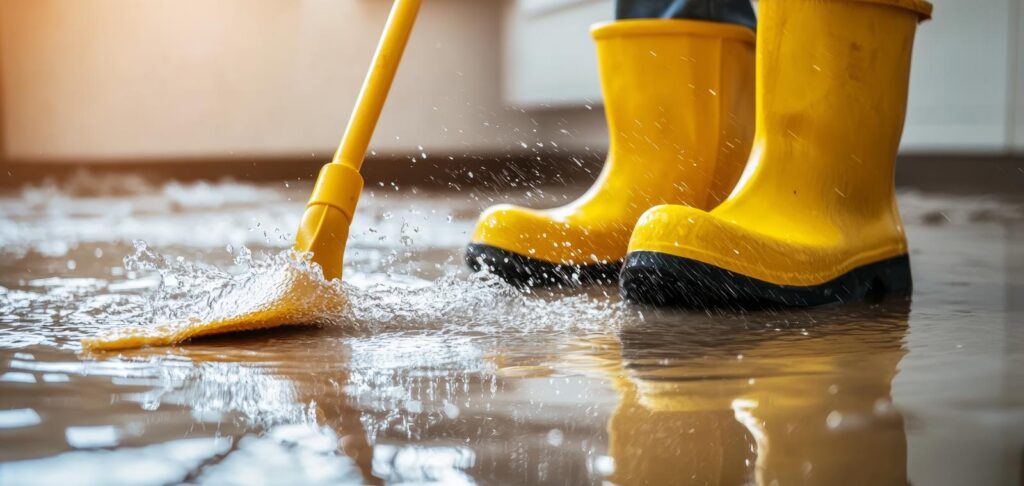
Contents
A flood can feel like a storm sweeping through your home, leaving chaos in its wake. When faced with flood damage, knowing the right cleanup techniques is essential. You’ll need to act swiftly to minimize loss and prevent further issues. The journey to recovery begins with water extraction, followed by drying and sanitizing. Understanding these steps can make all the difference in restoring your space effectively. What comes next is vital for your home’s safety and integrity.
Key Takeaways
- Conduct a thorough damage assessment to identify structural issues and safety hazards before starting cleanup.
- Utilize effective water extraction methods like submersible pumps and wet vacuums to remove standing water quickly.
- Implement high-velocity fans and dehumidifiers to ensure rapid drying of affected areas and prevent mold growth.
- Clean and sanitize surfaces with EPA-approved products to eliminate contaminants and protect health.
- Consider hiring professionals for specialized techniques and equipment to enhance the restoration process.
Assessing the Damage and Safety Precautions
How do you begin evaluating the damage after a flood? Start with a thorough damage assessment, focusing on both structural and personal property.
Before stepping inside, verify you’ve taken necessary safety measures. Check for hazards like downed power lines or unstable structures. Wear protective gear, including gloves and boots, to safeguard yourself against contaminants.
Once you’re in, document the damage with photos for insurance purposes. Look for signs of structural issues, such as cracks in walls or ceilings, and check the electrical system for any water exposure.
Don’t forget to evaluate your belongings; items like furniture and electronics may need special attention.
Connecting with professionals can also enhance your assessment process. They can offer insights and guidance, verifying you feel supported.
Water Extraction and Drying Techniques
Effective water extraction and drying techniques are vital for minimizing damage after a flood. You need to act quickly to prevent further issues like mold and structural damage. There are various water removal methods available, including submersible pumps, wet vacuums, and specialized extraction equipment. Each method has its benefits depending on the extent of the flooding.
In addition, utilizing the right drying equipment options is essential for thorough restoration. High-velocity fans and dehumidifiers can greatly speed up the drying process, protecting your home from secondary damage.
Here’s a quick overview of common techniques:
| Water Removal Methods | Drying Equipment Options |
|---|---|
| Submersible Pumps | High-Velocity Fans |
| Wet Vacuums | Dehumidifiers |
| Extractors | Air Movers |
| Sump Pumps | Industrial Dryers |
Implementing these techniques can guarantee your home is restored effectively and safely.
Cleaning and Sanitizing Affected Areas
Once you’ve completed the water extraction and drying process, it’s vital to focus on cleaning and sanitizing the affected areas to eliminate contaminants and prevent health risks.
This step is imperative for restoring your home and ensuring your family’s safety. Here are some effective techniques you can use:
- Use EPA-approved cleaning products: Choose cleaners specifically designed for flood damage, ensuring they effectively eliminate bacteria and mold.
- Apply sanitizing methods: After cleaning, use a disinfectant to sanitize surfaces, especially in kitchens and bathrooms.
- Scrub porous materials: For carpets or upholstery, consider deep cleaning or replacing items that absorbed contaminated water.
- Ventilate the area: Open windows and use fans to enhance air circulation, aiding in drying and reducing mold growth.
Final Thoughts
To summarize, tackling flood damage effectively hinges on swift action and proper techniques. Did you know that according to the National Flood Insurance Program, just an inch of water can cause up to $25,000 in damage? By prioritizing water extraction, thorough drying, and meticulous cleaning, you can greatly reduce the risk of mold and long-term structural issues. Don’t underestimate the importance of these steps—taking them seriously can make all the difference in your recovery journey.
Recent Posts
Uncovering Secrets: Swift Basement Flood Recovery Hacks
A basement flood can feel like a nightmare, while swift recovery can bring a sense
3 Best Water Removal Solutions for Basement Flooding
When dealing with basement flooding, choosing the right water removal solutions is essential. Submersible pumps,
7 Effective Solutions for Basement Flooding Cleanup
When facing basement flooding, it’s essential to act quickly and methodically. First, assess the situation
